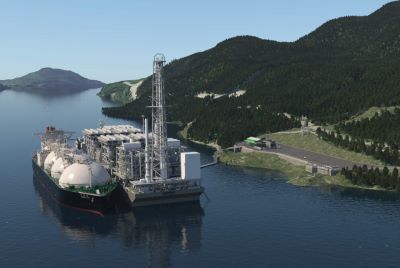Canada can capitalize on the “era of electricity” but needs to overcome barriers to a clean energy system
Canada has the natural resources, the technologies and the knowhow to take advantage of huge opportunities in the “era of electricity” but first must dismantle the barriers blocking a clean energy transition.
That was the overarching message from speakers at The Walrus Talks Power Economy: “Using electricity to change cities, homes and industry,” an event presented by Concordia University and Volt-Age.
Canada will need to at least double the amount of clean electricity generated on transmission grids to meet the country’s net-zero greenhouse gas emissions target by 2050, experts say.
 However, “The shift to clean energy isn’t just a story about cutting emissions. It’s a story about building industries that will define our country’s prosperity for the next 50 years,” said Susan McGeachie (photo at right), founding partner and CEO of the Global Climate Finance Accelerator affiliated with the University of Toronto.
However, “The shift to clean energy isn’t just a story about cutting emissions. It’s a story about building industries that will define our country’s prosperity for the next 50 years,” said Susan McGeachie (photo at right), founding partner and CEO of the Global Climate Finance Accelerator affiliated with the University of Toronto.
“Here in Canada we are at a crossroads,” she said. “We can double-down on business as usual or we could make a bold choice to treat electrification and decarbonization not as costs to the economy, but as the foundation of a new, future-proof [economy].”
Transitioning to an electricity-powered, clean energy economy isn’t about ideology; it’s about responding to markets and risk management, McGeachie said.
“Canada has the minerals, the engineers, the large pools of capital and the knowhow to structure the right policy, technology and investment pathways to get there,” she said. “The opportunity is ours for the taking. We decide.”
 “We have entered the era of electricity,” said Moe Kabbara (photo at left), executive vice-president at the Transition Accelerator, a non-profit organization that works with 300+ partner organizations to build pathways to a low-carbon economy.
“We have entered the era of electricity,” said Moe Kabbara (photo at left), executive vice-president at the Transition Accelerator, a non-profit organization that works with 300+ partner organizations to build pathways to a low-carbon economy.
Global energy transitions don’t just change the way countries fuel their needs, he noted. “They completely flip the script on which countries matter, which economies thrive and which technologies become possible.”
“It is critical for Canada to take action and lean into electricity if we want to matter technologically, economically and geo-politically,” Kabbara said.
Doubling the amount of clean electricity in the next 25 years sounds like a daunting task. However, he pointed out that Canada actually doubled its electricity grid every 10 years when the nation first started building and electrifying the country.
“Oil did built the 20th century economy. But electricity will build and is building currently the technological economy of the 21st century,” Kabbara said.
“We need to make sure that Canada is leading this [energy transition] instead of watching from the sidelines.”
Canadians need a vision to see that electricity is the foundation of economic power in the age of artificial intelligence and solving climate change,” Kabbara said. “Regardless of where you are on the political spectrum, regardless of your economic ideologies, it’s very clear that Canada has an opportunity here to benefit from this.”
 Rick Smith (photo at right), president of the Ontario-based Canadian Climate Institute, said “In order to solve climate change, we need to electrify pretty much everything and we need to make sure that we are producing that electricity in a non-polluting way.”
Rick Smith (photo at right), president of the Ontario-based Canadian Climate Institute, said “In order to solve climate change, we need to electrify pretty much everything and we need to make sure that we are producing that electricity in a non-polluting way.”
Renewable energy sources “are quite simply the most cost-effective sources of energy ever devised,” he said.
Solar power costs have fallen by more than 90 percent over the past decade and in most places in Canada, heat pumps are cheaper to operate than the fossil-fuelled alternatives, he noted.
“The energy transition is a transition that’s going to make our lives better,” Smith said. “Because of that, it’s going to happen sooner than we think.”
Canada’s power economy needs to be a “shared value economy”
 Over the next two years, 95 percent of the electricity growth demand globally is going to be met by renewables, said Rachel Doran (photo at right), executive director of Vancouver-based Clean Energy Canada.
Over the next two years, 95 percent of the electricity growth demand globally is going to be met by renewables, said Rachel Doran (photo at right), executive director of Vancouver-based Clean Energy Canada.
“In almost every jurisdiction globally, renewable energy is becoming the cheapest new source of demand and generation production,” she said.
In Canada, each province either has a procurement ongoing for renewable energy or renewable energy projects are being built, she added.
Canada has the ninth-largest economy in the world but is next door to the U.S. with the world’s largest economy, Doran noted. It is now Canada’s moment to figure out a Canadian approach to its own national energy system, she said.
She pointed out that all of Canada’s largest export markets after the U.S. are countries that still have industrial carbon pricing, net-zero targets and electric vehicle regulations. Half of these countries also have border adjustment mechanisms to limit the amount of carbon in imported energy and other products.
When it comes to relying on fossil fuels, “Is it a safe bet to be betting on something the world is going to want less of?” Doran asked.
.jpg) In making the shift to electrification, Canada’s power economy “should be a shared value economy,” said Chris Henderson (photo at left), curator, transformative energy and president of Lumos Energy, and founding executive director of Indigenous Clean Energy.
In making the shift to electrification, Canada’s power economy “should be a shared value economy,” said Chris Henderson (photo at left), curator, transformative energy and president of Lumos Energy, and founding executive director of Indigenous Clean Energy.
In Canada’s drive to accelerate major projects that are in the national interest, he said, “We must not degrade or eliminate regulations and frameworks that protect habitat and species, or run roughshod over Indigenous sovereignty with measures like special economic zones [like those proposed by the Ontario government].
Henderson noted that there are more than 300 renewable energy projects operating across Canada with Indigenous partners, “all built in the last 15 years and more to come.”
He pointed to the Watay Power project in northern Ontario, co-owned and jointly developed by Indigenous communities and private partners, that is connecting 17 remote communities to the provincial electricity grid so they no longer have to rely on diesel-fuelled power.
“Watay is building a new transmission corridor through the boreal forest while respecting and protecting species habitat and sacred Indigenous lands and waters,” Henderson said.
“If we embrace and practice the principles of social inclusion for a power economy, politics, policy and projects converge,” he said.
 Emily Whetung-MacInnes (photo at right), director, Indigenous partners at Ontario Power Generation (OPG) pointed to the potential of nuclear power, saying she “came to love the way that nuclear [energy] has a smaller footprint, it’s non-emitting and it manages every cubic millimetre of waste it produces.”
Emily Whetung-MacInnes (photo at right), director, Indigenous partners at Ontario Power Generation (OPG) pointed to the potential of nuclear power, saying she “came to love the way that nuclear [energy] has a smaller footprint, it’s non-emitting and it manages every cubic millimetre of waste it produces.”
At OPG, she said, “I work to make sure there are Indigenous owners of all of OPG’s greenfield projects going forward.”
Henderson offered three principles to guide the “build-it-fast” approach to major projects put forward by the Mark Carney government.
First, denominate demand for a power economy, he said. “If you lock in buyers for clean electricity for the long term with guaranteed supply, with set and gradually increasing prices, you have the capital backstop to build it.”
Second, “unbundle the morass of administrative processes,” the tangle of restrictions forestalling and lengthening project approvals, Henderson said. “In the desire to build perfect mousetraps, we have inadvertently found ourselves trapped in a quagmire of administrative processes, protracted timelines and arcane rules.”
“Public officials need to be unleashed and sufficiently resourced to move at scale with alacrity while maintaining the core function of government oversight for the public good,” he said.
Third, emphasize project execution to accelerate a power economy and reward performance for doing so, he said.
A collaborative effort is required across the country to develop decarbonized infrastructure through linking long-term demand and supply relationships, Henderson said.
 Faye Diamantoudi (photo at right), dean of graduate studies and professor of economics at Concordia University, said Concordia’s Volt-Age program brings together more than 140 established researchers across various disciplines, with a joint vision to address the technical aspects of electrification as well as the societal and policy-oriented challenges.
Faye Diamantoudi (photo at right), dean of graduate studies and professor of economics at Concordia University, said Concordia’s Volt-Age program brings together more than 140 established researchers across various disciplines, with a joint vision to address the technical aspects of electrification as well as the societal and policy-oriented challenges.
Volt-Age, supported by a $123-million grant from the Canada First Research Excellence Fund, is Canada’s No. electrification research program.
Investment in clean energy must be “democratized”
McGeachie said investment in Canada’s shift to clean energy must be “democratized” by ensuring that small and medium-sized businesses actively participate in and benefit from Canada’s national electrification efforts.
“The mid-market is the backbone of the Canadian economy,” she noted. “Finding the ‘how’ to ignite this engine will turn policy ambition into real-world impact.”
Doing so also will help diversify Canada’s economy by ensuring that SMEs can shape, not just access, the clean economy, McGeachie said. “It means moving beyond enabling investment for a few large players, to a decarbonization landscape in which everyone can participate.”
Democratizing access to clean energy investment can build a more diversified, resilient economy, she said.
“It would create a culture of shared ownership and excitement around the clean energy transformation, rather than the current indifference we’re experiencing because most people are excluded from the upside of decarbonization.”
She pointed to Norway establishing its Sovereign Wealth Fund, now worth over US$1.6 trillion and founded on revenues from the country’s oil and natural gas industry.
Norwegians had to be convinced that the purpose of the country’s money-making oil and gas resource should be to invest in a diversified economy, McGeachie said. “It took a deliberate, hard-won effort on the part of government, civil society and industry.”
“In doing this structure, Norway saw oil not as a forever fuel but as a temporary windfall to buy time for what’s next,” she said. “That mindset shift was just as important as any industrial policy or legislation.”
In contrast, in Canada “competitiveness within our national borders and the related interprovincial barriers are one of the greatest threats to our economy,” McGeachie said.
Many provinces are rich in clean energy resources. “But we lack the interprovincial transmission infrastructure needed to move electricity efficiently across the country.”
At the same time, major electrification projects are subject to navigating federal regulations, provincial permitting, municipal zoning and sometimes multiple court challenges, she said. “All of which could be subject to political turnover or policy reversals.”
“Investors don’t fear regulation. They fear unpredictability,” McGeachie said.
Another challenge is that raising the investment capital across provinces to pay for infrastructure and other projects in the national interest “is a legal and logistical headache.”
Securities regulation is fragmented, making it more expensive to raise capital in Canada for businesses trying to operate or attract investors across multiple provinces, she said.
Investing in clean electricity opens the door to entire industries, such as battery recycling, green hydrogen, electric vehicle supply chains, data centres powered by renewables, and others, McGeachie said.
“The economic and social opportunities ahead of us are massive and there’s still time to capitalize on them,” she said.
Kabbara noted that China, which generates about 30 percent of the world’s electricity, has been dubbed as the world’s first “electro-state.”
“China has realized that the future is electric. They dominate the renewable supply chains, the critical mineral supply chains, the battery supply chains” he said. “For [Canada] to be able to compete globally, we need to catch up.”
The electrification of Canada will offer opportunities across all regions in the country, including enabling meaningful Indigenous reconciliation “by offering and extending real economic opportunities and ownership to Indigenous Nations to participate in this economic opportunity for the country,” Kabbara said.
However, it is imperative that Canada act now to overcome barriers and take advantage of the economic and social opportunities that electrification offers, said Smith from the Canadian Climate Institute.
“In order to ensure a sustainable future for human life on Earth, in order to stop global warming, we must meet the scientifically established goal of net-zero emissions by 2050,” he said. “So the clock is ticking. Time is of the essence.”
R$
| Organizations: | |
| People: | |
| Topics: |
Events For Leaders in
Science, Tech, Innovation, and Policy
Discuss and learn from those in the know at our virtual and in-person events.
See Upcoming Events
You have 0 free articles remaining.
Don't miss out - start your free trial today.
Start your FREE trial Already a member? Log in
By using this website, you agree to our use of cookies. We use cookies to provide you with a great experience and to help our website run effectively in accordance with our Privacy Policy and Terms of Service.





